LittaTraps help stop rubbish’s journey to sea
27 May 2021, 9:10 AM
A multi-agency effort is trapping rubbish before it can find its way into the sea and shedding new light on plastic; one of the most common pollutants of our oceans.
In a bid to determine how much plastic and other litter is reaching Taitokerau’s rivers and estuaries annually, the Northland Regional Council is working with NorthTec, Whitebait Connection, the Northland District Health Board, the region’s three district councils and local businesses to install LittaTraps.
 Manue Martinez with some of the LittaTrap contents audited recently at NorthTec.
Manue Martinez with some of the LittaTrap contents audited recently at NorthTec.
Regional councillor Amy Macdonald says the devices are a simple, cost-effective net that fits inside a stormwater grate, trapping plastic and other litter that would otherwise be carried by stormwater straight into the sea.
She says as part of the study 50 traps have been installed around Northland to capture a variety of different land uses, for example playgrounds, carparks, supermarkets, fast food premises and industrial sites.
Dr Manue Martinez from NorthTec will audit the traps’ contents every three months and will try to estimate how much plastic is finding its way into the sea.
“The first audit has just been carried out with a total of 4160 items captured after just three months.” “The data is also revealing a big difference between sites; one site at a city centre car park in Whangārei had more than 500 items, while two sites (a residential street in Dargaville and a commercial office in Whangārei) had just two pieces of litter.”
 Some of the hundreds of cigarette butts recovered across a network of LittaTraps across Northland. All these butts were collected from just one trap.
Some of the hundreds of cigarette butts recovered across a network of LittaTraps across Northland. All these butts were collected from just one trap.
The data has also revealed that cigarette butts – which are made of a plastic called cellulose acetate – are the top litter item overall with 1322 butts found. (Cigarette filters are an environmental issue because they release a cocktail of chemical nasties and can take years to break down.)
Overall, the dominant source of litter was plastic (69%) followed by foamed plastic (8%).
Councillor Macdonald says plastics are an issue because they biodegrade extremely slowly and can harm or kill animals that ingest or get entangled in them.
“Discarded plastic items like drink bottles and cigarette butts will break down into smaller and smaller pieces over time.” “These smaller items are potentially more dangerous to marine animals and much harder to clean up.” “Plastic rubbish also impacts on the aesthetics and amenity value of our coast.”
Organisers hope the study will help them identify some high-risk land uses and commonly occurring rubbish so they can target mitigation and education. They’re also looking for any seasonal trends, for example there may be more ice cream wrappers in summer.
“Stormwater systems are designed to manage flood risk and the water is not typically treated so everything that goes down the drain will end up in the sea,“ Cr Macdonald says.
She says everyone can do their bit by disposing of litter and cigarette butts in a bin and helping to reduce the amount of plastic finding its way to the ocean. Where appropriate, business owners could also consider installing a LittaTrap at their business.

Pictured during the installation of a rubbish-catching LittaTrap at Onerahi, Whangārei, late last year are, from left, Whangārei District Councillor Nicholas Connop, Manue Martinez from NorthTec, Kim Jones of Whitebait Connection, Northland Regional Councillor Amy Macdonald and Shelley Butt of Sustainable Coastlines.
